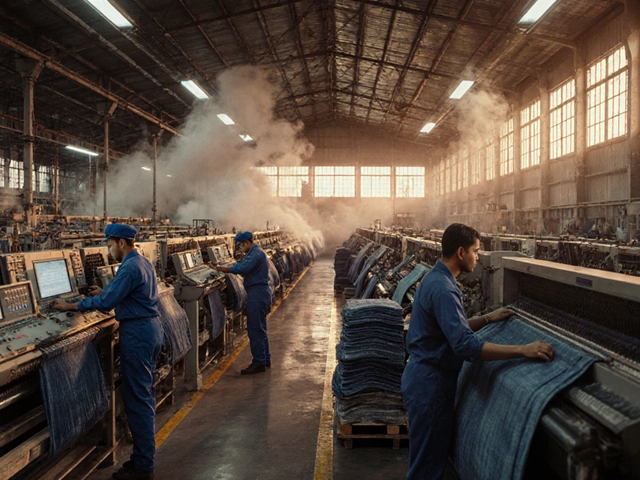If you're thinking small businesses can't make a big splash, think again. Micro small scale industries are everywhere—making noodles in rented kitchens, running print shops in a back room, or stitching shoes in the garage. They're the backbone for a lot of economies, especially where jobs and cash flow are tight.
So what sets a micro small scale industry apart from the bigger fish? It's about the size of your team (usually 1–10 people), your investment (often under $100,000), and what you actually do every day. These aren’t just tiny factories—they can be bakeries, soap-makers, or even a dude with a laser engraver. Most of the time, people get started with just what they can afford, learning as they go.
Got a skill or a hobby? You might already be halfway there. These industries grow out of daily needs, local problems, or things someone wants done faster or cheaper. It’s less about having a business degree, more about spotting a gap and just going for it. That’s what makes micro small scale industry such a game-changer—almost anyone with determination (and a bit of patience) can give it a shot.
- What Makes an Industry 'Micro' or 'Small'?
- Common Types of Micro Small Scale Industries
- Why Start One? Key Benefits and Real Challenges
- How Do You Start: A Step-by-Step Guide
- Crucial Tips and Mistakes to Avoid
- Interesting Facts and Surprising Success Stories
What Makes an Industry 'Micro' or 'Small'?
Not every business gets called a micro or small scale industry. There are clear lines, and knowing where yours fits can save you a lot of headaches with paperwork and tax stuff. The official numbers can change depending on which country you’re in, but let’s break down what usually counts for most places.
The main cues are how much cash you put in and how many people work for you. Here’s what usually makes the cut:
- Micro industries: Invest up to $25,000 to $50,000 and hire less than 10 people. These are often home-based, family businesses, or single-person shops.
- Small industries: Go above the micro level but usually invest less than $1 million and employ anywhere from 11 to 50 people. Think small workshops, bakeries, tiny factories, or repair services.
The details change by country, though. In India, for example, micro enterprises invest less than 1 crore rupees in equipment, while in the U.S. a small manufacturer has fewer than 500 employees and up to $7.5 million in yearly sales. Keeping up with local rules is key.
| Type | Investment Limit | Typical Employees |
|---|---|---|
| Micro | Up to $50,000 | 1-9 |
| Small | $50,000 - $1 million | 10-50 |
But numbers aren’t everything. A micro small scale industry usually means you’re close to your customers, making things people actually need day-to-day. No fancy offices or long chains of command. Most decisions come from the owner themselves. You can adapt fast, test new ideas on the fly, and keep costs down because you're not dealing with huge overhead.
Knowing where you stand helps when you go look for government help, small business loans, or grants. Lenders and agencies often use these classifications to say who gets what support, so being clear on your label is a smart move.
Common Types of Micro Small Scale Industries
When folks talk about micro small scale industries, it’s not just a single type of setup. These businesses pop up in almost every corner of daily life—think handmade stuff, repair services, food production, and more. Usually, these are run by a handful of people out of homes, small rented spaces, or even street stalls. Below are some of the most common and practical examples you’ll see:
- Food Processing: This includes bakeries, home-based snack makers, dehydrated food packs, and micro dairies. One survey from 2023 found that nearly 20% of all micro small scale setups in developing regions are food-related.
- Textiles and Garments: Tailoring, embroidery, t-shirt printing, or custom clothing are hot choices. Small tailoring shops can see steady orders from local customers and nearby schools or companies.
- Woodworking and Furniture: From chairs and tables to carved signs and shelving, woodworking shops often start with basic hand tools and small workspaces.
- Repair and Maintenance: Phone, shoe, or small engine repair are practical businesses with steady demand—especially in places where folks would rather fix than toss out broken stuff.
- Printing and Stationery: Sticker printing, custom invitations, copies, and small print runs for local businesses. This works great even with just one or two machines in a tiny store.
- Crafts and Handmade Goods: Jewelry, scented candles, pottery—anything that appeals to gift-buyers or neighborhood markets. A lot of these businesses ride the wave of online selling and local fairs.
Here’s a quick look at some easy-to-understand stats on the most popular sectors for these industries worldwide:
| Industry Type | % of Micro Small Scale Industries (2023 Data) |
|---|---|
| Food Processing | 20% |
| Textiles/Garments | 18% |
| Crafts & Gifts | 14% |
| Repair Services | 13% |
| Printing & Stationery | 9% |
| Wood/Furniture | 8% |
| Other Services | 18% |
The beauty of micro small scale industry is that you don’t need a massive loan or big fancy machines to get rolling. A ton of these businesses start because someone tries to solve a real problem right in their own backyard. If you’ve got a skill, you can probably turn it into something marketable, especially if you keep things local and practical.
Why Start One? Key Benefits and Real Challenges
Jumping into a micro small scale industry isn't just for dreamers—it's a practical move for lots of folks looking for real freedom, more control, or just a reliable income. The best part? You don’t need a mountain of cash to get started. All you need is a bit of know-how, some grit, and a clear idea of what people want in your area.
Let’s break down the upsides first. Here are the big benefits:
- Low entry barrier: You rarely need more than a modest investment to get the ball rolling. Some people start with just a couple hundred bucks—a used sewing machine or a small dough mixer, for example.
- Flexibility: You call the shots. Most folks run these businesses close to home, picking hours that suit their family or even a day job.
- Local impact: Micro industries provide real jobs and services for neighbors and pump money into local economies. The International Labour Organization says these businesses make up more than 70% of employment in some developing countries.
- Fast pivots: If something stops selling, it’s not that hard to switch products or services since you haven’t sunk a fortune into complicated machinery or huge stockpiles.
But don't skip the hard stuff! There are some tough realities you should know about before diving in:
- Cash flow headaches: Small projects can dry up fast, and you might not have savings to buffer slow months. It's smart to keep an emergency fund.
- No room for laziness: Every customer counts. If you get a bad review or let quality slip, word spreads quickly in a small market.
- Red tape: Even tiny businesses often have to wrangle with paperwork, local permits, or health and safety checks. Check those boxes from the start.
- Limited growth: There are only so many hours in a day or hands in a family, so scaling up can be tricky without extra investment or hiring help.
Still thinking about getting started? Here’s what people love AND what keeps them up at night, all in one glance:
| Benefit | Challenge |
|---|---|
| Low startup cost | Hard to get loans from banks |
| You manage your hours | Hard to take breaks/hard to find time off |
| Direct customer relationships | Word-of-mouth can make or break you |
| Quick setups and pivots | Easier for competitors to copy you |
| Easy to learn by doing | Can get stuck at the same level |
One more thing to chew on—according to a recent survey in 2024, over 75% of small business owners said their biggest reward is the sense of direct impact they make. They're not just filling orders; they’re building trust, one deal at a time. That’s why you see so many of these businesses grow slowly but survive for years, even with big stores or new tech crowds all around them.

How Do You Start: A Step-by-Step Guide
Jumping into a micro small scale industry can feel like stepping into the unknown. Don't worry—it's not rocket science. It comes down to planning, a bit of hustle, and sticking to the basics. Here's how everyday folks get their businesses off the ground:
- Pick What You Know (or Can Learn)
Look around: What skills do you already have? Know how to make jam, fix machines, or sew clothes? Start where you're comfortable. If you need to upskill, YouTube and free courses are your friends. - Check Local Demand
Ask people in your area or network if they’d buy what you’re planning to sell. You don’t want to start a bakery if everyone’s gluten-free, right? A few quick chats can save you months of wasted time. - Get Your Paperwork Sorted
Depending on where you live, you might need to register your business, grab a trade license, or set up a GST number (especially if your sales climb past a certain level). Many countries now let you do this online without paying a lawyer. - Plan Your Budget
Micro small scale industries usually kick off with less than $10,000, often even less. Make a basic list: equipment, raw materials, rent (if any), and some spare to handle surprises. - Find a Space
Start at home or rent a tiny workshop. Lots of famous brands began in garages—like Amazon and Apple. Point is, don’t waste cash on fancy premises. - Buy Smart
Grab only the tools and raw materials you need right now. Secondhand gear is fair game—look for bargains online or from local businesses closing down. - Spread the Word
Use free social media. WhatsApp, Facebook groups, even flyers at the local grocery store. Your first customers will probably be people you know or their friends. - Tune and Improve
Be quick to adapt. If something isn’t selling, ask why and tweak it. The best feedback comes straight from early customers, so keep your ears open.
| Item | Estimated Cost |
|---|---|
| Basic Equipment | 1,500–3,000 |
| Initial Raw Materials | 500–2,000 |
| Business Registration & Licenses | 100–600 |
| Space Rent (1 month, optional) | 500–1,200 |
| Utilities & Miscellaneous | 200–400 |
If cash is short, check if your local government or banks have schemes for small businesses. Many offer low-interest startup loans or grants just for these kinds of industries.
One last thing—don't expect to get rich overnight. Most micro small scale businesses start slow but steady. Stick with it, learn from every mistake, and you'll see real progress sooner than you think.
Crucial Tips and Mistakes to Avoid
Most people jump into a micro small scale industry with big dreams and zero planning. Don’t make that mistake. Here’s how to stay ahead.
- Always know your costs. I’ve met folks who didn’t even count electricity or rent until they checked their empty wallets. Fill out a simple spreadsheet before you start. Add every small expense, even that coffee you drink while working.
- Keep records from day one. Write down your sales, expenses, stock—everything. Cloud-based apps work great (many are free) or go old-school with a notebook. Missing records can turn taxes into a nightmare.
- Never skip legal basics. Register your business and check local regulations. Running without permits can mean fines or shutdown, even if you’re selling something as simple as candles.
- Don't scale up too fast. See what works before ordering bulk supplies or hiring help. Tons of startups lose money by growing before they’re actually steady.
- Reach out to customers early. A lot of folks wait to make their product “perfect”—then nobody buys. Test your idea with real buyers—family, friends, neighbors—before going all-in.
- Watch the competition. Visit other small shops or check out online sellers. Learn what they charge, what people like, and what they complain about. This saves a ton of trial and error.
Here are some common rookie mistakes I’ve seen (and made):
- Mixing personal and business money. It messes up your math and, trust me, creates headaches when tax time rolls around.
- Ignoring small debts. A few bucks here and there adds up. Always track who owes you, and follow up fast.
- Assuming customers will just appear. Marketing—even if it’s just WhatsApp status or flyers at the grocery store—makes a real difference.
- Trying to do everything alone. Ask for help, or at least advice from someone who’s been there before. Two brains beat one.
Here’s a quick table with stats that might surprise you:
| Common Mistake | % of Micro Businesses Affected |
|---|---|
| Failing to register legally | 38% |
| Poor record-keeping | 52% |
| No clear price strategy | 41% |
| Scaling up too fast | 27% |
| Ineffective marketing | 49% |
Nail the basics, stay realistic, and spend that extra ten minutes a day tracking your numbers. The path of a micro small scale industry is easier when you work smart, not just hard.
Interesting Facts and Surprising Success Stories
Micro small scale industry has a huge impact but often goes unnoticed. Here’s something wild—a report from India’s Ministry of Micro, Small and Medium Enterprises in 2023 showed that micro and small businesses made up over 95% of all registered enterprises. In Nigeria, more than 30 million micro small businesses drive almost half the country’s economy. So, don’t underestimate the little guys—they keep national economies moving.
Here’s a table with some key stats that might surprise you:
| Country | No. of Micro Small Scale Industries | % of Total Businesses | Key Sectors |
|---|---|---|---|
| India | ~63 million | 95%+ | Textiles, Food, Electronics |
| Nigeria | ~41 million | 90%+ | Retail, Agriculture, Clothing |
| United States | ~31 million | 99% | Services, Food, Tech |
Now, onto some real-life game changers. There’s the story of Sarah, a single mom in Kenya who started upcylcing used flip-flops washed up on the beach. She hired a few locals, turned trash into funky toys, and soon, her products reached stores in Europe. She started as a micro small scale industry—now she’s got a team exporting worldwide.
Or think about The Millionaire Cleaning Lady, Sue in the UK, who built a cleaning business with just a mop and a bucket. Within three years, she trained other women in her neighborhood. Her team now has over 70 people, all from that small start.
Looking closer to home, my buddy Tom was out of a job in 2020. He started making custom pet collars with a sewing machine in his spare room (and yeah, my dog Rex was his first client). Fast forward to today, he’s moved from Facebook groups to an online store, and ships hundreds of collars every month. No big investors, just steady, slow growth, and super loyal customers.
Why do these stories matter? They show anyone can turn everyday problems or hobbies into a proper business—as long as you stay focused and flexible. Plenty of micro small scale industry wins are about local needs: fixing, making, or improving something people care about. The big lesson? Start small, but don’t think small. The most successful micro-businesses keep learning, keep adapting, and aren’t scared to dream a little.
- Tip: Always watch for gaps in your market—something as simple as homemade snacks or custom mugs can grow way beyond the kitchen table.
- Tip: The best marketing is often word of mouth. Deliver great service and let customers become your ambassadors.
- Tip: Don’t get too hung up on fancy gear or huge investment at the start—most micro small scale industry stories begin with what people already have.
One more important thing—don’t get discouraged by small beginnings. Almost every major company started as a micro small scale industry. Get the basics right, and you never know where things might go.




